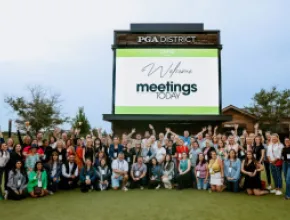SAN FRANCISCO
A new collaboration tool from Portland, Ore.-based startup Object Theory using Microsoft’s HoloLens augmented reality goggles could dramatically enhance the way remote teams work together, along with virtual participation in meetings.
Launched March 30 at the Microsoft Build Developer Conference in San Francisco, Object Theory’s Mixed Reality Collaboration service works with Microsoft’s HoloLens and Windows Holographic, allowing users to share 3D experiences from remote locations using life-size avatars.
Besides its initial use as a custom software program for Object Theory environmental architecture client CDM Smith, the tool could soon be used to enhance the events industry.
“For large-scale meetings, it could mean bringing in remote speakers who can join holographically on stage, and could be represented to the audience through very large screens. They would show up as being physically on stage,” said Raven Zachary, founding partner at Object Theory. “Or imagine having teams or meeting groups who are distributed remotely being able to come together in the same physical space and being able to interact much better than [they would be able to through] a crackling speaker phone.”
Zachary said that in the future, meeting environments could be recorded and stored, allowing attendees to leave notes on a whiteboard or engage in other activities through an immersive replay functionality.
The software was developed as part of the Microsoft HoloLens Readiness Program—Object Theory co-founder Michael Hoffman was a principal engineering lead at Microsoft Studios, and led the creation of showcase experiences for HoloLens—and includes a number of key features:
- Shared, remote experiences: Multiple users of the Microsoft HoloLens, regardless of location, can have a shared holographic experience with additional participants possible from a PC, tablet or mobile phone.
- Customized avatars: Each participant is represented in physical space by a full-sized avatar that is uniquely differentiated, with support for gaze, gesture and voice interaction.
- Display of 3D models: Import and display 3D content at any size, from tabletop to full scale for shared review and discussion, with the ability to navigate to points of interest in full-scale models.
- Annotations: Ability to add text, drawing and voice annotations that can be attached in 3D space.
In its current form the Mixed Reality Collaboration service would not be the most efficient use for, say, hundreds of users to interact at the same time (based on current tech). However, since the holographic experience can be shared with those on PCs or mobile devices, viewers could still participate while a core number of HoloLens-wearers lead the proceedings. And even if a significant number of participants are goggled-up, they all can still share a small environment without “crowding” each other out.
“We were doing a demonstration in a constrained room that would only fit four people, but we had a bunch of other avatars in the room with us,” Zachary said. “Because they’re avatars, they can move through our bodies. We can have the same meeting, but not have to deal with constrained space.”
While the visual representation of avatars is currently a bit nondescript in the product, Zachary said the future will assuredly bring improvements to the avatars’ look, allowing for more accurate stand-ins.
“Once you put on the HoloLens you quickly become comfortable with avatars as humans in the same way we’re comfortable on Skype seeing an avatar of a person’s face,” Zachary said. “Someday we may see a full-body 3D avatar, but it’s enough now that you can become comfortable with co-workers.”
And compared to relatively high-priced holographic virtual meeting environments such as Starwood’s TelePresence meeting suites, the use of HoloLens hardware could dramatically lower the cost of service.
“HoloLens sort of democratizes prices on this a bit, other than what’s out there already,” Zachary said. “I think this technology is going to change the ability of people to participate from a distance.”
Here's a demo video of Object Theory's Mixed Reality Collaboration software in action (no audio).







